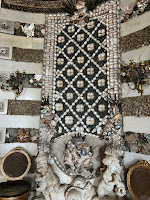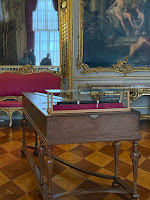Today's adventure took us to Potsdam by train. Upon arriving, we walked to Sanssouci Palace Complex, a UNESCO World Heritage Site.
I am going to preface my tour details with some information about Frederick the Great as this will provide context for this complex.
Frederick II of Prussia, known as Frederick the Great was born January 24, 1712, the son of the authoritarian King Frederick William I and Sophia Dorothea of Hanover. His childhood was marked by conflict with his father, who despised Frederick's love of French culture, philosophy, and the arts, preferring military discipline. Frederick's interests in arts and philosophy conflicted with his father's militaristic and authoritarian views. The relationship between father and son became strained and at 18 years old, Frederick tried to flee Prussia to England with his friend Hans Hermann von Katte. The escape plot was discovered, and both Frederick and Katte were arrested. Frederick William I imprisoned his son in the fortress of Küstrin. He also forced Frederick to watch the execution of his friend Katte, who was beheaded for his role in the escape plan. After his release, Frederick was stripped of his military rank and forced to undergo rigorous training in statecraft and administration.
This period of imprisonment and the traumatic experience of witnessing Katte's execution profoundly impacted Frederick, shaping his personality and approach to leadership.
Frederick embodied the Enlightenment ideals:
- Philosopher King: Corresponded extensively with Voltaire and other leading intellectuals
- Religious Tolerance: Proclaimed "In my kingdom, everyone can go to heaven in his own way"
- Cultural Patron: Supported arts, literature, and architecture throughout his reign
- Multilingual Scholar: Fluent in German, French, Latin, and Italian
- Musical Composer: Accomplished flutist who composed over 100 sonatas and four symphonies
But, he was also a great military strategist, and using the army his father put together, he transformed Prussia from a minor German state into a major European power:
- Seven Years' War (1756-1763): Successfully defended Prussia against a coalition of Austria, France, and Russia
- Silesian Wars: Conquered resource-rich Silesia from Austria, doubling Prussia's population
- Military Innovations: Revolutionized battlefield tactics and army organization
- Strategic Acumen: His victories at Rossbach (1757) and Leuthen (1757) are studied in military academies worldwide
And he made administrative reforms including: - Legal Code: Established comprehensive legal reforms promoting equality before the law
- Agricultural Innovation: Introduced potato cultivation, helping prevent famines
- Religious Freedom: Protected minorities and encouraged immigration
- Education: Founded schools and promoted literacy throughout Prussia
Frederick the Great was likely homosexual. Historians say he was primarily attracted to men and had a number of male lovers, while his marriage to Elisabeth Christine of Brunswick-Wolfenbüttel was unconsummated and he largely avoided her after their initial duty was fulfilled. Evidence for his homosexuality includes the close personal relationships with several men including his page and Hans Hermann von Katte and openly displayed affection for them. He wrote poems and letters that contain homoerotic themes and explicit references to male sexuality. He filled his palaces with homoerotic artwork and created Sanssouci as a male sanctuary, banning women. Contemporaries like Voltaire and Casanova, who knew Frederick personally, alluded to his homosexual preferences. For more about his sexuality, click HERE.
For more general information about Frederick the Great, click HERE.
We started our visit to the area at The Neues Palais which was built between 1763-1769 by Frederick the Great. Frederick himself called the Neues Palais his "fanfaronade" - essentially built to show off Prussian wealth and power after the Seven Years' War nearly bankrupted the kingdom. Unlike the intimate Sanssouci Palace (which we visited later), this was designed to impress foreign dignitaries and show that Prussia remained financially strong despite the devastating war.

The palace has more than 200 rooms and is one of the largest in Europe. Built in the Baroque style. Some of the more noteworthy rooms we visited included:
- The Shell Grotto with over 20,000 shells and minerals from around the world decorating its walls.
- The Lower Concert Room with wood paneling to improve acoustics and specially designed seating integrated into the frames of the paneling.
- The Oval Closet with its Meissen porcelain chandelier, the paneling on the walls and ceiling with colored flower garlands and gilded palm leaves (by lacquer-work artist Sebastian Chevalier.
The Marble Hall (shown to the right) has almost 6,500 square feet of floor space and spans across two floors. Unfortunately as the Marble Hall is directly above the Grotto Hall, Frederick insisted that the latter shouldn't include any load bearing pillars. That meant that the floor, weighing 90 tons rests on a timber structure spanning a distance of almost 60 feet. Just eight years after it was built, it was at risk of collapse and had to be reinforced. Remedial work has continued through the years.
Our almost 2 km walk from Neues Palais to Sanssouci Palace took us through one of Europe's greatest landscape gardens with varying landscapes along the way. We passed the Orangery Palace built on behest of the "Romantic on the Throne", King Friedrich Wilhelm IV from 1851 to 1864, the Sicilian Garden and a beautiful fountain.



From here, we headed up the steps to the Sanssouci Palace built by Frederick the Great as his summer palace between 1745 and 1747, it is often counted among the German rivals of Versailles. While Sanssouci is in the more intimate Rococo style and is far smaller than its French Baroque counterpart, it, too, is notable for the numerous temples and follies in the surrounding park. "Sanssouci" means "without worry" in French, reflecting Frederick's desire for a place of leisure away from court protocol.
The picture below was taken from the top of the steps and looks out into the gardens.
After experiencing the grand scale of Neues Palais, Sanssouci felt remarkably intimate with 12 Rooms (vs. 200+ for Neues Palace), a single story horizontal design embracing the landscape and Rococo intimacy with its delicate, refined decoration vs. the Baroque boldness of Neues Palace. This palace was built when Frederick was young, optimistic and focused on arts and philosophy.
The Small Gallery is decorated with an excess of Rococo ornamentation. These embellishments swirl around the works of art for which this room was specially created. The theme of the painting is a light-hearted and carefree life with the natural world.
Every evening in the Music Room, the King listened to concerts or played music himself and he continued to do so until well into old age. In the picture to the right you can see his flute lying on the piano. The pianoforte is original for its time and it was even played by one of Johann Sebastian Bach's sons, Carl Philipp Emanuel Bach. The composer lived and worked at Frederick's court for almost thirty years.My favorite room in the palace was the Voltaire Room (or Fourth Guest Room) with its garlands of flowers, fruits and animals. All the flowers and fruits in the room represent plants grown in Sanssouci's Parks and greenhouses. Responding to an invitation from Frederick the Great, the French writer and philosopher arrived at the Prussian court in 1750 and stayed for 3 years.
After our visit to the palace, we took a bus into Potsdam's historic town center. Here there is diverse cultural heritage with both Dutch and Russian influences.
The Dutch Quarter was built 1733-1742 under Frederick William I to attract Dutch craftsmen. The Russian colony was built 1826-1827 for Russian singers in the Prussian court. These immigrant communities brought specialized skills and cultural diversity to the Prussian court city.
We had an expensive ice cream at one of the cafes along the Main Street and we passed by the Potsdam Clock Tower.
We walked through Old Market Square which forms the historical center of the city.
 |
| Panoramic View of the Old Market Square |
 |
| Christine & Irina |
We next headed to the Potsdam train station and took a short train ride to the Havel River and Lakes area where we visited Irina, a close friend of Richard and Christine's. Irina is from Poland and is an art dealer and former gallery owner (we had met her and been to her gallery in Basel when we lived there). She lives along the Havel River but is still active in the art world and represents clients internationally.
There we learned that her riverside home and those of her immediate neighbors, with the eastern side of the Berlin Wall running along the river bank below, were occupied by Stassi troups throughout WWII (who kicked out their Jewish owners), but when the Nazi’s surrendered, these villas became the different homes where Churchill, Truman and Stalin (and their respective entourages) occupied for the 2 weeks it took to hammer out the Potsdam agreement.
We had a lovely visit and while sitting out on her balcony, we enjoyed a late afternoon delicious homemade dinner of traditional German herring (marinated for 30 minutes in lemon juice) and prepared with onions and regional Yukon Gold potatoes .
After our visit we headed back to Berlin via train to prepare for our return to this area for a cruise on the lakes.

























Comments